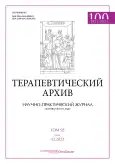The effectiveness of targeted therapy of various genetically engineered biological drugs in the treatment of bronchial asthma
- Authors: Shogenova M.S.1,2, Hutueva S.H.1, Shogenova L.S.3
-
Affiliations:
- Center of Allergology and Immunology
- Berbekov Kabardino-Balkarian State University
- State Scientific Center “Institute of Immunology”
- Issue: Vol 95, No 12 (2023)
- Pages: 1112-1118
- Section: Original articles
- URL: https://journals.rcsi.science/0040-3660/article/view/258738
- DOI: https://doi.org/10.26442/00403660.2023.12.202491
- ID: 258738
Cite item
Full Text
Abstract
This article presents the experience of successfully switching therapy from omalizumab 150 mg to benralizumab 30 mg/1 ml in a patient with a combined allergic and eosinophilic phenotype in the presence of hypersensitivity to nonsteroidal anti-inflammatory drugs. The effectiveness of biological therapy was evaluated when switching from omalizumab 150 mg subcutaneously at a dose of 600 mg for 36 weeks. Therapy for the drug benralizumab 30 mg/1 ml subcutaneously the first three injections monthly, the rest a month later for 52 weeks with bronchial asthma (BA), a severe uncontrolled course with a combined allergic and eosinophilic phenotype in the presence of hypersensitivity to nonsteroidal anti-inflammatory drugs in a patient Ch., born in 2004. Switching therapy from omalizumab 150 mg to benralizumab 30 mg/1 ml allowed to achieve complete control of asthma symptoms (AST = 23 points), to achieve the absence of asthma exacerbations during 52 weeks, restore respiratory function to normal values, as well as improve the quality of life. The study reflects the good tolerability, high efficacy and safety of biological therapy when switching from one genetically engineered biological drug (GIBP) omalizumab 150 mg to another GIBP benralizumab 30 mg/1 ml in severe uncontrolled asthma with a combined allergic and eosinophilic phenotype in the presence of hypersensitivity to nonsteroidal anti-inflammatory drugs. Therapy with benralizumab 30 mg/1 ml in severe BA has demonstrated a more effective clinically significant improvement in the course of the disease, control of symptoms of the disease. Reduction of exacerbations, normalization of respiratory function indicators, complete control of the disease has been achieved. Consequently, the use of different biological molecules for the therapy of BA with a combined allergic and eosinophilic phenotype contributes to achieving disease control, improving the patient's quality of life and reducing the dose of oral glucocorticosteroids. The targeted biological drug benralizumab 30 mg/1 ml has a targeted effect on the key links in the pathogenesis of severe uncontrolled asthma with a combined allergic and eosinophilic phenotype in the presence of hypersensitivity to nonsteroidal anti-inflammatory drugs and reduces the burden of severe disease.
Full Text
##article.viewOnOriginalSite##About the authors
Madina S. Shogenova
Center of Allergology and Immunology; Berbekov Kabardino-Balkarian State University
Author for correspondence.
Email: shogmad@yandex.ru
ORCID iD: 0000-0001-8234-6977
д-р мед. наук, глав. врач ГБУЗ «Центр аллергологии и иммунологии», проф. каф. факультетской терапии ФГБОУ ВО «КБГУ им. Х.М. Бербекова», гл. внештатный аллерголог-иммунолог Минздрава КБР
Russian Federation, Nalchik; NalchikSvetlana H. Hutueva
Center of Allergology and Immunology
Email: shogmad@yandex.ru
ORCID iD: 0000-0002-4126-1202
д-р мед. наук, проф., зав. аллерго-иммунологическим отд-нием
Russian Federation, NalchikLaura S. Shogenova
State Scientific Center “Institute of Immunology”
Email: shogmad@yandex.ru
ORCID iD: 0000-0001-8048-1278
ординатор
Russian Federation, MoscowReferences
- Anderson GP. Endotyping asthma: new insights into key pathogenic mechanisms in a complex, heterogeneous disease. Lancet. 2008;372(9643):1107-19. DOI:10.1016/ S0140-6736(08)61452-X
- Bai TR, Vonk JM, Postma DS, Boezen HM. Severe exacerbations predict excess lung function decline in asthma. Eur Respir J. 2007;30(3):452-6. doi: 10.1183/09031936.00165106
- Hancox RJ, Pavord ID, Sears MR. Associations between blood eosinophils and decline in lung function among adults with and without asthma. Eur Respir J. 2018;51(4):1702536. doi: 10.1183/13993003.02536-2017
- Ненашева Н.М. Биологическая терапия тяжелой астмы: новые цели и новые возможности лечения. Медицинский совет. 2019;(15):50-61 [Nenasheva NM. Biological therapy of severe asthma: new targets and new treatment options. Medical Council. 2019;(15):50-61 (in Russian)]. doi: 10.21518/2079-701X-2019-15-50-61
- Moore WC, Meyers DA, Wenzel SE, et al. Identification of asthma phenotypes using cluster analysis in the Severe Asthma Research Program. Am J Respir Crit Care Med. 2010;181:315-23. doi: 10.1164/ajrccm-conference.2012.185.1_meetingabstracts.a3625
- Haldar P, Pavord ID, Shaw DE, et al. Cluster analysis and clinical asthma phenotypes. Am J Respir Crit Care Med. 2008;178:218-24. doi: 10.1164/rccm.200711-1754oc
- Siroux V, Basagana X, Boudier A, et al. Identifying adult asthma phenotypes using a clustering approach. Eur Respir J. 2011;38:310-7. doi: 10.1183/09031936.00120810
- Chung KF, Bel EH, Wenzel SE. Difficult-to-Treat Severe Asthma. Eur Respir Soc Monograph. 2011;51:310. doi: 10.1183/1025448x.erm5110
- Ненашева Н.М. Биологическая терапия бронхиальной астмы: настоящее и будущее. Consilium Medicum. 2016;18(11):30-8 [Nenasheva NM. Biological therapy of asthma: present and future. Consilium Medicum. 2016;18(11):30-8 (in Russian)]. doi: 10.26442/2075-1753_2016.11.30-38
- Shaw D, Sousa A, Fowler S, et al. Clinical and inflammatory characteristics of the European U-BIOPRED adult severe asthma cohort. Eur Respir J. 2015;46:1308-21. doi: 10.1183/13993003.congress-2015.oa1461
- Сергеева Г.Р., Емельянов А.В., Коровина О.В., и др. Тяжелая астма: характеристики пациентов в клинической практике. Терапевтический архив. 2015;87(12):26-31 [Sergeeva GR, Emelyanov AV, Korovina OV, et al. Severe asthma: description of patients in clinical practice. Terapevticheskii Arkhiv (Ter. Arkh.). 2015;87(12):26-31 (in Russian)]. doi: 10.17116/terarkh2015871226-31
- Ненашева Н.М. Т2-бронхиальная астма: характеристика эндотипа и биомаркеры. Пульмонология. 2019;29(2):216-28 [Nenasheva NM. T2-asthma, endotype characteristics and biomarkers. Russian Pulmonology. 2019;29(2):216-28 (in Russian)]. doi: 10.18093/0869-0189-2019-29-2-216-228
- Locksley RM. Asthma and allergic inflammation. Cell. 2010;140(6):777-83. doi: 10.1016/j.cell.2010.03.004
- Moore WC, Panettieri RA, Trevor J, et al. Biologic and maintenance systemic corticosteroid therapy among US subspecialist-treated patients with severe asthma. Ann Allergy Asthma Immunol. 2020;125:294e303. doi: 10.1016/j.anai.2020.04.004









